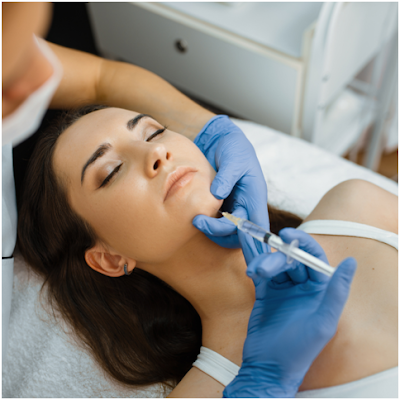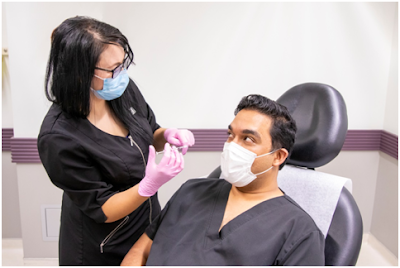Botox for Chin: Why You Should Get it & What to Expect During the Treatment
Getting Botox on the chin is not something many thought about or opted for previously. However, due to the positive results associated with it, the trend for Chin Botox has increased rapidly over the past few years.
What is Botox?
Botox originates from the bacteria known as Clostridium Botulinum and the Botulinum Toxin, which is the active ingredient found inside Botox, is found to exist in 7 different forms, including A, B, C, D, E, F, and G. Out of all these forms, Type ABotulinum Toxin is most popularly used for aesthetic purposes. It is administered to the body via a series of injections by a trained professional, which leads to an immediate effect.
Botox is commonly used for purposes of antiaging due to its ability to smooth out wrinkles and fine lines and lead to a younger-looking face. Botox may also be used for other purposes on the body, including reduction of sweat production, which is found to be particularly beneficial in individuals who have excessive sweating from their underarms.
Why is Botox Administered to the Chin?
The shape of an individual’s chin is determined by the structure of their bone and the overlying soft tissues like the skin, muscles, and fatty layers. The muscle which is present at the chin is known as the mentalis muscle and is often responsible for the chin irregularities. Moreover, the pointed part of the chin is most commonly dependent on the soft tissues overlying the bone instead of the shape of the bone itself, so if one wants to alter the shape of their chin or make it smoother, they may not have to undergo a surgical procedure. Injection of Botox into the chin can lead to the relaxation of the mentalis muscle, which may allow it to descend downwards and improve the appearance of a blunted chin. (2)
Along with
improving the contour of the chin, Botox can also reduce bunching and tension
in the chin area, which can help treat the following
aesthetics concerns on the chin:
∙ Chin Wrinkles
∙ Deep Chin Creases
∙ Dimpling of the Chin
∙ Double Chin
How Does Botox For Chin Work?
When you move the muscle of the face, the receptors in your face send signals to your brain about every movement. When Botox is administered to the chin, it leads to inhibition of this chemical messenger and prevents its effect on the muscle.
Since the communication between the brain and muscle allows the contraction of the muscle, once this communication is blocked, it leads to muscle relaxation.
Since it is the contraction of muscles that cause dimpling and wrinkling of the overlying skin of the chin, its relaxation leads to smoothening of the skin for a temporary period of time – for as long as the Botox injection lasts .
How is Botox For Chin Administered?
Botox injections are usually available in an insulated glass, which should be kept in the refrigerator at a temperature of either -5 in frozen form or at 2 to 8 degrees. When you go to the injector to get your Botox injections, they may start with carefully evaluating your face and marking the points with a washable marker where they need to inject the Botox. In the case of the chin, careful markings are made depending on the concerns of the individual. Botox injections are usually delivered to the target muscle instead of the subcutaneous tissue above it – unless it is a rare case or a specific requirement of the individual. Since the incorrect dose and incorrect levels of the injection needle can lead to harmful and undesirable effects, it is best to get the Botox injections from trained and specialized injectors with years of experience.
Moreover, since a fast insertion of the contents of injection onto the muscle may cause pain to the patient, the injector may conduct slow insertion in order to minimize the mechanical stimulation. After the Botox injection, the individual is asked to press on the injection site to prevent swelling, bleeding, or bruising. However, if the injector feels that a bruise is starting to develop, they may use an ice pack on the site of the injection.
Since it is a small, non-invasive, and pain-free procedure, individuals may come in between work to get their Botox injections.
How Much Does Botox For the Chin Cost?
Since getting a Botox for aesthetic purposes is considered an elective procedure, it is not usually covered by health insurance plans. In order to avoid any misunderstandings, the amount and mode of payment should be discussed with the injector beforehand, which may be calculated on the basis of the number of Botox injections that are to be used and the area of the body covered.
While some injectors like to charge per appointment, the others may charge on the volume of Botox that is used per patient – hence the rate seems to vary from injector to injector. The usual cost for a Botox procedure may range between $400 to $450. However, this may be higher if you get the treatment from a highly experienced and renowned injector, if you want a large area of your body to be covered by the Botox procedure or if you are getting the injection from a clinic that is located in an area with a high cost of living.
However, clinics like Lucere offer their clients pocket-friendly packages to get their Botox treatment from their highly experienced injectors, which make the dream of getting a Botox treatment more attainable.
Who is a Good Candidate For Botox Treatment?
The ideal candidate for the Botox to the chin is someone who is experiencing wrinkles or dimpling of their chin or has an irregular and asymmetrical shape of the chin due to contraction of the muscles. Moreover, if you are planning to get a Botox treatment, you should not be doing so under the influence of your friends or family and expecting results that is similar to them. This is because every individual has their unique anatomy and structure of their musculature and soft tissue; hence one thing that has worked for someone you know may not present identical results for you.
Before the start of the Botox treatment, you should have a thorough discussion with your injector about what you expect out of the treatment and what your main concerns are. The injector will then evaluate your face thoroughly and go through your medical history, after which they will inform you to what extent your concerns may be addressed and what kind of results the Botox treatment will be able to give you.
Are There Any Side Effects Of Botox For Chin?
According to Alberta Health, the common side effects that may be experienced with Botox injection include swelling, redness, pain, and slight bleeding from the injection sites – however, these are temporary and are seen to heal quickly. These are completely avoidable if the injector uses thinner needles and dilutes the Botox with a little bit of Saline.
The rare but longer-lasting side effects of Botox include headaches which may last for up to 2 to 4 weeks – however, these can be treated by using pain killers. Nausea, Ptosis, and flu-like symptoms may also be reported rarely.
How Long Does The Effect of Botox For Chin Last?
The effects of Botox are generally found to last around three months on average. However, some studies have also shown these to last for up to 4 to 5 months – depending on the type of formulation used, the technique of injection, and the area of the body.
Botox For Chin At Lucere
Since the administration of the Botox injection, which includes the type of needle used and the depth of penetration, has the potential to drastically affect the outcome of the Botox treatment, one should always try to get their treatment done from trained and experienced professional injectors. With over 5000 injections being delivered each year at Lucere, out injectors have vast experience and know exactly what they are doing, helping you to have a pain-free experience and achieve your desired results!
Get your free consultation at Lucere now, and get started on your Botox journey!







Comments
Post a Comment